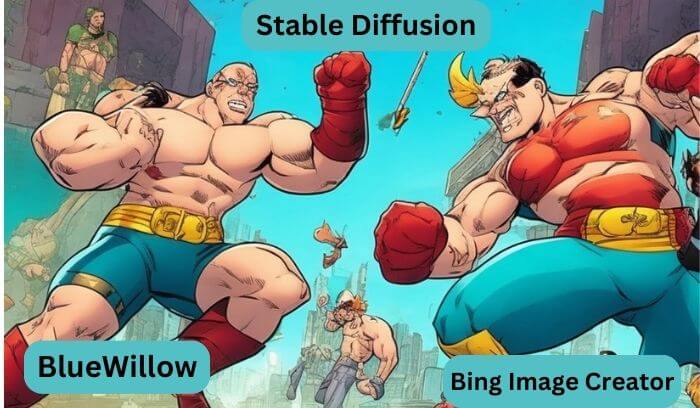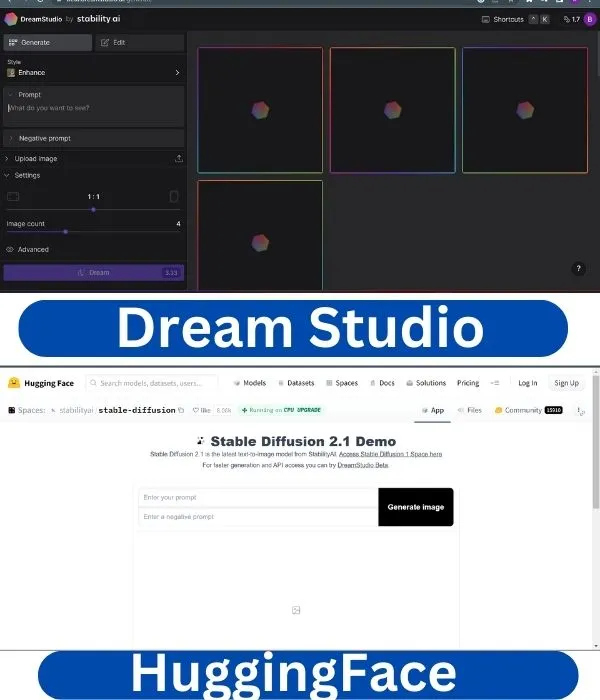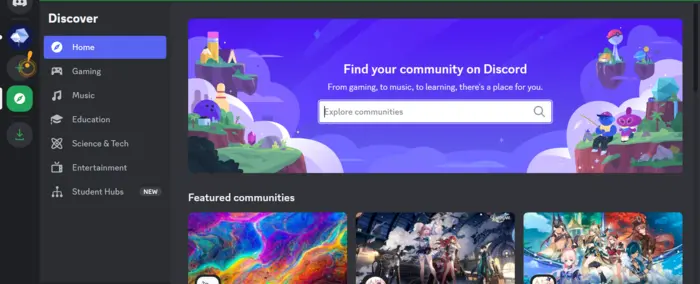Are you exhausted from spending hours searching for the perfect images to enhance your projects? Look no further!
In this article, we’ll explore the world of image creation tools and compare three popular options: Stable Diffusion, Bluewillow, and Bing Image Creator.

Whether you’re a social media manager or a designer, finding high-quality images that align with your vision can be a daunting task.
But worry not! We’re here to simplify the process and assist you in making an informed choice.
Stable Diffusion, BlueWillow, and Bing Image Creator are three powerful tools that seek to revolutionize the way you create visuals. Each tool has its unique features, advantages, and limitations.
By the end of this article, you’ll have a clear understanding of which tool best suits your needs.
So, grab a cup of coffee, sit back, and let’s delve into the world of Image Generators.
Stable Diffusion:

Stable Diffusion is open-source, allowing anyone to use and customize it for their own needs. This makes it a valuable tool for researchers and developers interested in exploring text-to-image generation possibilities.
Here you can also modify images based on text and enhances low-resolution images.
It is trained on billions of images, and it rivals DALL-E 2 and MidJourney in performance. But DALL-E 2 and MidJourney are not free.
That’s why today we are discussing its comparison with Bluewillow and Bing Image Creator. Because you can use both of them for free.
Key Features: You can use sable diffusion in various ways:
you can install it on your device or may run it on Google Colab.
Otherwise, you may use huggingface.co(Hugging Face develops ML tools, including the notable Transformers library and a platform for sharing models and datasets.) or DeamStudio(the Official website of Stable diffusion) by Stability AI.

For instant, we are using DreamStudio and HuggingFace to explore its capabilities.
Despite a slightly cluttered layout compared to DALL-E 2 and Midjourney, Stable Diffusion in DreamStudio remains user-friendly. As a trial user, you’ll receive 200 free credits to create prompts.
Enter your prompts in the designated box, or utilize the Negative Prompt box to exclude specific elements.
You may also use the left menu’s essential features, which influence the overall image and credit usage.
You’ll find Style options, Upload Image, and Settings (to adjust ratio and the number of generated images).
The Advanced tab offers additional options like Prompt Strength, Generation Steps, Seed, and Model.
Remember, hovering over each option is a chance to learn more about its function. To truly grasp their practical effects, experimentation is key.
Just be mindful of your credits, as it’s not a one-credit-per-image system. Otherwise, you should buy extra credit.
Pros & Cons:
It is important to weigh the pros and cons carefully before deciding whether or not to utilize it for a specific application like stable diffusion. So, let’s see
Pros:
User-friendly: With a few clicks, Stable Diffusion may create an amazing image that would take hours or days to create manually.
High-quality images: It can enhance image features, improve image stability, and generate excellent images from low-quality sources.
Free: Anyone with powerful hardware can install and run it.
Text-to-image conversion: Stable Diffusion is best for creating detailed images from text descriptions.
Applications: It has numerous applications, including image synthesis, inpaintimg, and image restoration.
Cons:
Learning curve: While Stable Diffusion is user-friendly, mastering it requires time and experimentation with different parameters.
Computational intensity: Stable Diffusion can be demanding on system resources, posing a challenge for some users.
Limited options: Compared to Midjourney, Stable Diffusion offers fewer customization options for image creation.
Task suitability: Choosing the right model depends on the specific editing task, and Stable Diffusion may not be ideal for all scenarios.
Hardware requirements: To run Stable Diffusion, you need a device with at least 4GB of VRAM.
BlueWillow:

It’s completely free and it creates stunning images using AI technology. The best part is, it’s designed to be super user-friendly so that you can use it, regardless of your experience or expertise.
Imagine having your own personal artist right on your Discord server! BlueWillow is a Discord bot that brings together various AI models, like Midjourney, to transform any command into fantastic artwork.
Whether you need a logo, a beautiful landscape, a unique character, or even digital art, BlueWillow can do it.
All you have to do is describe the image you want, and BlueWillow’s AI-powered tool will work its magic to create the perfect visual for your project.
Key Features:
Free and stunning: BlueWillow is an AI artwork generator that produces captivating images at no cost.
User-friendly: Our image-generating AI is designed for everyone, regardless of skill level. Create incredible images effortlessly with our accessible tool.
Versatile image creation: BlueWillow AI converts any prompt into art, spanning logos, landscapes, characters, and digital artwork.
Fast and accurate: By leveraging multiple AI models, including Stable Diffusion, BlueWillow excels in speed and accuracy compared to other free image generators.
Pros & Cons:
Now you know. It is important to be aware of the limitations of the service before you decide to utilize it.
Pros:
Free and versatile: BlueWillow is a user-friendly AI image generator that caters to a wide range of prompts, from logos to digital artwork free of cost.
Enhanced prompts: BlueWillow provides valuable tips for generating high-quality AI artwork prompts.
Cons:
Image quality: While BlueWillow produces good results, it may not match the quality of images created with Midjourney.
Limited options: BlueWillow offers fewer customization options compared to Midjourney.
Early stage: BlueWillow is still evolving and may not have all the desired features for designers.
Platform choice: BlueWillow operates on Discord, which may not suit all designers’ preferences.
Flexible pricing: BlueWillow offers a paid subscription but follows a Pay What You Can (PWYC) model, accommodating various designer needs.
Stable Diffusion vs BlueWillow:
| Feature | Stable Diffusion | BlueWillow |
|---|---|---|
| Type of model | Deep learning, text-to-image model | Image-generating AI |
| Accessibility | An open-source model that can be used on most consumer hardware with a modest GPU | Accessible only via Discord |
| Cost | Free | Free |
| Quality of generated images | 4 out of 5 | 3 out of 5 |
| User-friendliness | Not as user-friendly as BlueWillow | Easy-to-use and accessible for all. |
| System requirements | An NVIDIA graphics card, preferably with 4GB or more of VRAM | You can use online using any type of device |
Winner: It depends on your demand and knowledge. If you have a better understanding of prompts, then BlueWillow will be a good choice for you. However, if you possess strong technical expertise in image generators, then Stable Diffusion is the best option.
Bing Image Creator:

Introducing Bing Image Creator, powered by DALL·E! Originally launched in October 2022 as a limited preview in select markets, it’s now an exciting new feature for the new Bing and Microsoft Edge, announced in March 2023.
Leveraging OpenAI’s groundbreaking DALL∙E 2 technology, which is an advanced version of DALL∙E, it enables users to generate images from text prompts.
Key Features:
Now you can create stunning images effortlessly with Bing Image Creator. Because It’s free and accessible to anyone with a Microsoft account on Windows 10 and Windows 11 devices.
Great news for Microsoft Edge users! Bing Image Creator is now available directly within Microsoft Edge, making it the first and only browser with an integrated AI-powered image generator.
As a new user, you can enjoy 25 boosted generations with Bing Image Creator for faster processing times.
You also may unlock even more speed by redeeming Microsoft Rewards for additional boosts.
Pros & Cons:
Pros
Experience simplicity and intuitiveness. No technical skills or artistic talent are required.
Enjoy speed and responsiveness. Generate images in seconds and customize them effortlessly.
Here, you can unleash your creativity with versatility and flexibility. Bring any imagined concept to life, from realistic photos to abstract art.
Cons:
Please note that image prompts are currently limited to English only. Support for other languages is not available at the moment.
Results may vary. The AI system has the potential to misinterpret prompts, resulting in distorted faces, hands, or text that may be difficult to read.
Originality may vary as well. Since the AI system is trained using a vast library of online images and text, generated images may bear a resemblance to existing ones or lack a certain level of uniqueness.
Stable Diffusion vs Bing Image Creator:
| Feature | Stable Diffusion | Bing Image Creator |
|---|---|---|
| Type of model | Deep learning, text-to-image model | AI-powered visual Stories |
| Quality of generated images | 4 out of 5 | 3.5 out of 5 |
| User-friendliness | Not as user-friendly as Bing Image Creator | Easily create images by describing them, adding details such as location or activity, and selecting an art style. |
| System requirements | An NVIDIA graphics card, preferably with 4GB or more of VRAM | Access to Bing.com and a Microsoft account |
Winner: If you want to generate based on a pre-made art style, then Bing Image Creator is suitable. However, for more detailed and highly customizable images, you should definitely choose Stable Diffusion.
Comparison: Stable Diffusion vs Bluewillow vs Bing Image Creator
Here we use some prompts in these three image generators and further we discuss the key points which you should remember when to choose. So, let’s see the prompts and results:

Prompt to create the Image: A funny and cute cat, walking hand in hand with a big and dashing tiger with a smile. The background of the image features a beautiful forest scene, with lush trees and sunlight shining through the leaves.
1st one Generated by: BlueWilllow
Middle One Generated by: Bing Image Creator
Last one Generated by: Stable Diffusion
Quality of generated images:
Stable Diffusion: An advanced AI algorithm that synthesizes text into images. It generates coherent visuals based on prompts, resembling photos or sketches.
BlueWillow: Experience the power of a free AI artwork generator. Transform any prompt into stunning, AI-generated art.
Bing Image Creator: Unleash your creativity with a range of templates and styles. The quality of your generated images depends on your input and template selection.
Winner: Stable Diffusion
Training Requirements:
Stable Diffusion: Utilizes a “diffusion” process to generate images by training a neural network to reverse the added noise.
BlueWillow: Harnesses Stable Diffusion for the creation of photo-realistic images from text input.
Bing Image Creator: A web-based tool that enables image creation with various templates and styles, without the need for training.
Winner: BlueWillow
Flexibility and Customization:
Stable Diffusion provides flexibility and customization options, allowing users to create personalized images. NightCafe Creator enables users to adjust settings for enhanced image generation.
BlueWillow focuses on user-friendliness and accessibility, making it easy for users to create stunning images effortlessly by providing a prompt.
With Bing Image Creator, users have access to a variety of templates and styles. Personalize images by adding text and personal images.
Winner: Stable Diffusion
User Interface and Accessibility:
Stable Diffusion provides a user-friendly interface, allowing for the effortless generation of unlimited free Stable Diffusion creations with NightCafe Creator.
BlueWillow presents an accessible online interface for image creation using the innovative Stable Diffusion model.
Bing Image Creator features a web-based interface that is user-friendly and accessible to all.
Winner: Bing Image Creator
Cost and Licensing: Finally, when considering the cost and licensing terms associated with each image generator, compare factors such as pricing models, commercial usage restrictions, or open-source availability. It’s worth noting that all image generators are free.
Moreover, since an image created using your own prompts belongs to you, it is universally usable.
Which One is Better? – Final Thought
Thank you for reading the article. By understanding all the aspects, we can conclude that Stable Diffusion is a great choice for users seeking a free and open-source image generator that can be installed on a local PC.
On the other hand, Bluewillow Image Generator offers a user-friendly experience. Bing Image Creator serves as an excellent option for users desiring a free AI-powered visual Stories tool integrated into the Bing chat experience. Ultimately, the selection of an image generator tool depends on your specific needs and preferences.
